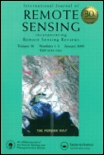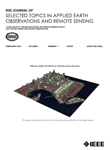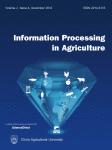
CANADIAN JOURNAL OF REMOTE SENSING
Scope & Guideline
Advancing Knowledge in Earth and Planetary Sciences
Introduction
Aims and Scopes
- Remote Sensing Applications:
The journal emphasizes practical applications of remote sensing data in areas such as agriculture, forestry, urban planning, and environmental monitoring, showcasing how remote sensing can address real-world challenges. - Technological Innovations:
There is a strong focus on new methodologies, technologies, and algorithms for processing and analyzing remote sensing data, including machine learning and deep learning techniques. - Interdisciplinary Research:
The journal encourages research that integrates remote sensing with other scientific disciplines, such as ecology, climatology, and geography, to address complex environmental issues. - Data Fusion Techniques:
A consistent aim is to explore the integration of multi-source remote sensing data (e.g., optical, SAR, LiDAR) to improve the accuracy and applicability of remote sensing analyses. - Regional Studies:
The journal frequently publishes studies that focus on specific geographic regions, particularly within Canada, to highlight local environmental issues and management practices.
Trending and Emerging
- Machine Learning and Deep Learning Applications:
There is a significant increase in the use of machine learning and deep learning techniques for various applications, including image classification, object detection, and data analysis, reflecting the technological advancements in these areas. - Hyperspectral Remote Sensing:
Emerging interest in hyperspectral imaging is evident, with a rise in studies focusing on its applications in agriculture, forestry, and environmental monitoring, showcasing its potential for detailed spectral analysis. - Environmental Monitoring and Climate Change Studies:
A growing number of papers focus on using remote sensing for monitoring environmental changes and assessing impacts related to climate change, highlighting the importance of remote sensing in understanding and managing ecological issues. - Integration of Multi-Source Data:
There is a trend towards integrating different types of remote sensing data (e.g., combining SAR, LiDAR, and optical data) to enhance analysis accuracy and provide more comprehensive environmental assessments. - Urban Remote Sensing:
Emerging research in urban remote sensing is becoming more prevalent, focusing on urban planning, infrastructure monitoring, and the effects of urbanization on the environment.
Declining or Waning
- Traditional Statistical Methods:
There is a noticeable decrease in the use of conventional statistical methods for remote sensing analysis, as more researchers turn towards machine learning and AI-driven approaches. - Basic Remote Sensing Techniques:
The journal has seen fewer papers on basic remote sensing techniques, such as simple image processing or single-source analysis, as the field advances towards more integrated and complex methodologies. - Land Cover Classification Using Simple Algorithms:
Studies focusing solely on basic land cover classification with rudimentary algorithms are becoming less frequent, overshadowed by more sophisticated machine learning models.
Similar Journals

PRECISION AGRICULTURE
Empowering agriculture with innovative research.PRECISION AGRICULTURE is a leading journal in the field of Agricultural and Biological Sciences, published by SPRINGER. With its ISSN 1385-2256 and E-ISSN 1573-1618, the journal has earned a prestigious reputation, holding a Q1 ranking in its category for 2023, placing it in the top 4% nationally and ranking 8th out of 221 in Scopus. Since its inception in 1999, it has provided a vital platform for researchers and practitioners alike, focusing on innovations in the realm of precision farming practices and technologies designed to enhance agricultural productivity and sustainability. Although not an open-access journal, it provides an exceptional resource through high-quality, peer-reviewed articles that cover diverse topics within precision agriculture. The editorial objectives emphasize the dissemination of cutting-edge research, methodologies, and case studies, making it an invaluable asset for anyone involved in modern agricultural research and practices. PRECISION AGRICULTURE remains an essential publication for advancing knowledge and fostering collaboration within the precision agriculture community.

South African Journal of Geomatics
Advancing Geospatial Knowledge for a Sustainable FutureSouth African Journal of Geomatics is a pivotal platform dedicated to the advancement of geomatics, focusing on the dynamic intersection of geographic information science, surveying, and mapping technologies. Published by CONSAS CONFERENCE, the journal serves as a crucial resource for researchers, professionals, and students in the geomatics field, providing insightful, peer-reviewed articles that explore contemporary challenges and innovations. Operating under an open-access model, the journal ensures the wide dissemination of knowledge, promoting collaboration and scholarly exchange among the global geomatics community. With a commitment to enhancing the visibility of significant research and fostering academic discourse, the South African Journal of Geomatics plays a vital role in contributing to the development of this essential discipline in South Africa and beyond.

Journal of Remote Sensing
Bridging Disciplines with Pioneering Remote Sensing ResearchThe Journal of Remote Sensing is a leading scholarly publication dedicated to advancing knowledge and research in the field of remote sensing. Published by the American Association for the Advancement of Science, this open-access journal, which has been available since 2021, strives to provide an inclusive platform for researchers, professionals, and students alike to share transformative findings and innovative techniques related to Earth and planetary sciences, as well as their applications in social sciences and geography. With impressive Scopus rankings, placing it in the 94th percentile for Earth and planetary sciences and the 93rd percentile in geography, the journal is recognized for its high-impact contributions to the field. Researchers can access invaluable content without barriers, ensuring that the latest advancements in remote sensing technology and methodologies are widely disseminated and utilized. By fostering interdisciplinary collaboration and promoting high-caliber research, the Journal of Remote Sensing is becoming an essential resource for anyone interested in the intersection of technology and environmental studies.

Remote Sensing Letters
Unveiling New Perspectives in Remote Sensing ApplicationsRemote Sensing Letters, published by Taylor & Francis Ltd, is a distinguished journal that serves a vital role in the fields of Earth and Planetary Sciences as well as Electrical and Electronic Engineering. With an ISSN of 2150-704X and an E-ISSN of 2150-7058, this journal has been disseminating cutting-edge research since its inception in 2010, converging toward a future of innovation and technological advancement scheduled through 2024. The journal is recognized for its impactful scholarship, achieving a Q2 quartile ranking in both its categories as of 2023, highlighting its significance in enhancing academic discourse and applications in remote sensing methodologies. Although it does not operate under an open-access model, it provides access to essential findings that address contemporary challenges in the remote sensing domain. Located in the United Kingdom at 2-4 Park Square, Milton Park, Abingdon, OX14 4RN, Remote Sensing Letters is a crucial resource for researchers, professionals, and students committed to advancing their understanding and application of remote sensing technologies.

International Journal of Image and Data Fusion
Exploring the Synergy of Data and ImageryThe International Journal of Image and Data Fusion, published by TAYLOR & FRANCIS LTD, is a premier scholarly journal dedicated to the fields of computer science applications and earth and planetary sciences. With an ISSN of 1947-9832 and E-ISSN 1947-9824, this journal offers a unique platform for researchers, professionals, and students interested in the innovative integration of image processing and data fusion techniques. Operating from the United Kingdom, it plays a vital role in advancing knowledge and facilitating discussions in these rapidly developing domains, evidenced by its ranking within the Q3 category for Computer Science Applications and Q2 for Earth and Planetary Sciences in 2023. The journal features rigorous peer-reviewed content that spans from 2010 to 2024, encouraging the dissemination of novel research findings and methodologies. With a notable impact factor and strong Scopus rankings, it remains an essential resource for those seeking to enhance their understanding and application of sophisticated data fusion technologies in their academic or professional work.

INTERNATIONAL JOURNAL OF REMOTE SENSING
Shaping the Future of Earth and Planetary SciencesInternational Journal of Remote Sensing, published by Taylor & Francis Ltd, stands at the forefront of Earth and Planetary Sciences, providing a critical platform for disseminating pioneering research since its inception in 1980. With an impressive ranking of #25 out of 195 in general Earth and Planetary Sciences and a notable 87th percentile on Scopus, this journal is recognized for its high-quality contributions that span diverse topics including satellite imagery analysis, geospatial technologies, and environmental monitoring. As a Q1 journal in its field for 2023, it offers invaluable insights and methodologies that are essential for researchers, professionals, and students alike. Although not Open Access, the journal facilitates a comprehensive understanding of remote sensing sciences, ensuring that the scholarly community remains updated with the latest advancements, trends, and applications that impact global challenges.

Remote Sensing in Ecology and Conservation
Bridging technology and conservation for impactful environmental solutions.Remote Sensing in Ecology and Conservation is a pioneering journal published by WILEY that has been a beacon of open-access research since 2015. With an E-ISSN of 2056-3485, this journal stands at the forefront of the intersection between ecological research and technological innovation. It is recognized for its significant impact, boasting Q1 rankings across several prestigious categories in 2023, including Computers in Earth Sciences and Ecology, emphasizing its commitment to high-quality, influential scholarship. The journal provides a platform for researchers and practitioners to share their findings in remote sensing applications that advance ecological conservation efforts. Encompassing a broad scope that includes studies on landscape changes, biodiversity assessments, and environmental monitoring, it serves as an essential resource for education and practice in the field. With impressive ranks in Scopus, including a remarkable 6th place in Earth and Planetary Sciences, it continues to shape the dialogue in ecology and conservation. As an open-access journal, it champions the dissemination of knowledge, making critical research accessible to a global audience, thereby fostering innovation and collaboration in the pursuit of sustainable environmental practices.

Geographia Technica
Pioneering Insights into Socio-Environmental InteractionsGeographia Technica is an esteemed academic journal published by GEOGRAPHIA TECHNICA ASSOCIATION - GT Assoc in Romania, serving as a vital platform for the dissemination of cutting-edge research in the interdisciplinary fields of geography, planning, and earth sciences. Since its inception in 2009 and continuing through to 2024, the journal has established itself as a respected source of knowledge, reflected in its classification within the Q3 category across significant fields such as Computers in Earth Sciences, Earth-Surface Processes, and Geography, Planning and Development. With the ambition to enhance the understanding of socio-environmental interactions and technological applications in these areas, Geographia Technica invites scholars and practitioners to contribute original research that pushes the boundaries of current knowledge. Although currently not listed as open access, the journal's engaging content ensures it remains a valuable resource for researchers, professionals, and students keen on advancing their expertise in these dynamic disciplines.

IEEE Journal of Selected Topics in Applied Earth Observations and Remote Sensing
Pioneering Insights in Earth Observation Technologies.IEEE Journal of Selected Topics in Applied Earth Observations and Remote Sensing is a premier peer-reviewed journal published by the IEEE-INST ELECTRICAL ELECTRONICS ENGINEERS INC, focused on advancing the field of Earth observation and remote sensing technologies. With an impressive impact factor, this journal ranks in the top quartile (Q1) for both Atmospheric Science and Computers in Earth Sciences, underscoring its significance and influence in the academic community. Open access since 2020, it facilitates broader dissemination of research findings to enhance global visibility and accessibility for researchers, professionals, and students alike. Spanning the years from 2008 to 2024, the journal covers a myriad of topics that highlight innovative applications of remote sensing data and technologies in addressing environmental challenges. With a Scopus ranking placing it in the 91st and 89th percentiles, respectively, in its categories, the journal serves as a vital resource for advancing scholarly discourse and collaboration in Earth sciences.

Information Processing in Agriculture
Cultivating Knowledge: Bridging Agriculture and TechnologyInformation Processing in Agriculture, published by Elsevier, stands at the forefront of interdisciplinary research merging agriculture with cutting-edge computational techniques. With an impressive impact factor derived from its classification within the Q1 quartile across five critical categories—including Agronomy, Animal Science, Aquatic Science, Computer Science Applications, and Forestry—this journal exemplifies excellence in scholarly communication. Open Access since 2014, Information Processing in Agriculture not only democratizes access to pioneering research but also accelerates innovation by breaking barriers for researchers, professionals, and students alike. The journal's comprehensive scope facilitates crucial dialogue on the implications of processing technologies in farming practices, contributing significantly to advancements in sustainability and efficiency within the global agricultural sector. As it converges topics from 2014 to 2024, scholars are invited to explore and contribute to a robust platform dedicated to enhancing food security and environmental stewardship.